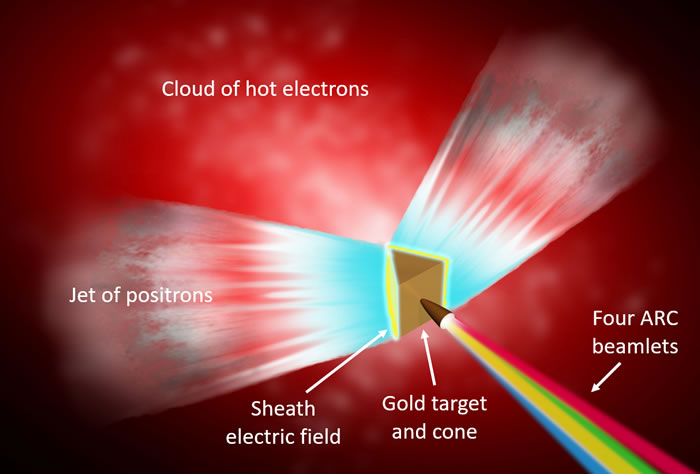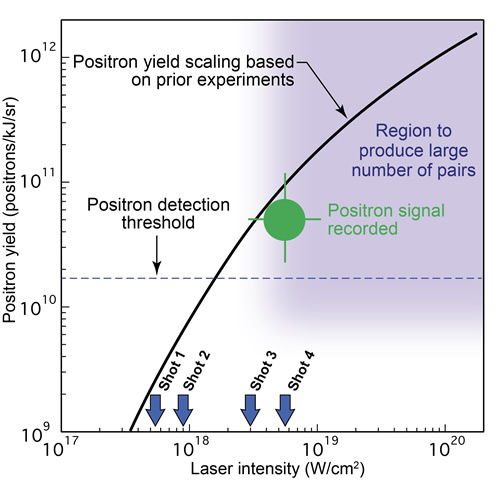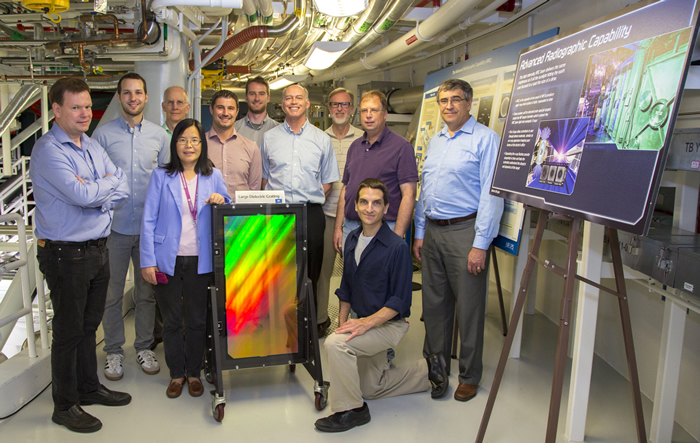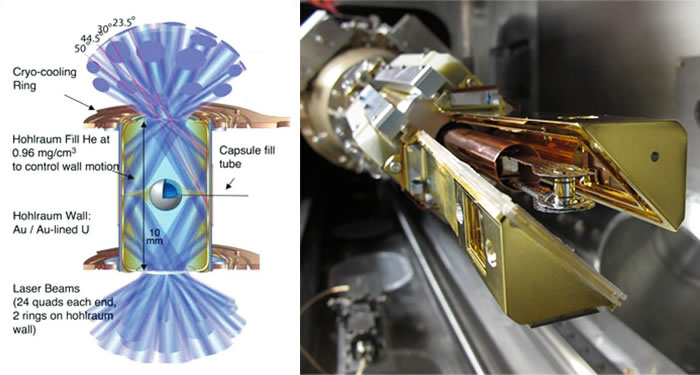Experimental Highlights - 2018
June
Why Ignition? NIF Experiments and Stockpile Stewardship
NIF Creates Matter and Antimatter from Light
For the first time at the National Ignition Facility, positrons—the antimatter “twins” of electrons—have been created and detected by LLNL researchers. Performed in May, the Discovery Science experiments showed that positron-electron pairs traveling at near light speed can be produced on NIF’s Advanced Radiographic Capability (ARC) laser using a new specially-designed plasma lens to increase the laser’s intensity.
The positrons emanated in jets from two sides of a gold target shaped like a triangular prism and mixed together with relativistic electrons to form a matter-antimatter plasma of electron-positron pairs. The studies could shed light on many high-energy processes occurring throughout the universe.
 The diagram shows ARC’s four laser beamlets striking the gold target’s cone, which reflects the light to the cone tip, increasing the laser intensity to reach the level needed to generate relativistic (near light speed) electrons that interact with the gold atoms to produce gamma rays. The gamma rays convert into electrons and positrons. The positrons exit the target in jets that interact with the hot electron cloud and then form the matter-antimatter plasma. Credit: Mark Meamber
The diagram shows ARC’s four laser beamlets striking the gold target’s cone, which reflects the light to the cone tip, increasing the laser intensity to reach the level needed to generate relativistic (near light speed) electrons that interact with the gold atoms to produce gamma rays. The gamma rays convert into electrons and positrons. The positrons exit the target in jets that interact with the hot electron cloud and then form the matter-antimatter plasma. Credit: Mark Meamber Although positrons have been generated using lasers at laboratories elsewhere, LLNL’s new results offer significant promise not only for astrophysics but for NIF’s primary stockpile stewardship missions of high energy density (HED) science and inertial confinement fusion (ICF).
In a Laboratory Directed Research and Development (LDRD) project lead by plasma physicist Hui Chen, the Pair Plasma team researched electron-positron pairs with other high-power, short-pulse lasers, such as the Titan laser at Livermore and the OMEGA EP laser at the Laboratory for Laser Energetics at the University of Rochester, well before ARC was commissioned.
“Matter-antimatter pairs are abundant in space—like in gamma-ray bursts near black holes and in neutron star collisions—and are almost a fundamental component of matter in the universe,” says Chen. “These new experiments are first steps. Our goal is to study the astrophysics of the most energetic processes in the universe here on Earth. Using ARC is how we hope to make it happen.”
As governed by Albert Einstein’s famous equation E=mc2 describing the equivalence of matter and energy, changing light to matter and antimatter is part of a series of physical processes allowing ARC to create the kind of electron-positron plasma that results when a massive star collapses.
Converting Light Energy into Mass
Ordinarily, when matter and antimatter interact, they instantaneously annihilate each other. When ARC fires with sufficient on-target laser intensity (power per unit area), however, it first generates relativistic electrons at a few million electronvolt (MeV) energies inside the gold target. The electrons move out of the target at very close to light speed and leave behind a sheath electric field—a strong electric field near the surface where they exited. But before this happens, collisions between some of these electrons and the gold atoms produce gamma rays. A single gamma ray can then rapidly transform from a high-energy, massless photon of light into a positron and an electron, both with mass.
The electric field that had been created by the relativistic electrons (negatively charged) attracts and accelerates the positrons (positively charged) to relativistic speeds and out of the target in high-flux and high-energy jets that mix with a cloud of relativistic electrons (hot electrons) gathered outside the target. Because the electrons and positrons are moving very close to the speed of light, there is little chance of them colliding with each other. Until they slow down and annihilate, there is a brief moment in time when they coexist as pairs.
The researchers initially were uncertain whether ARC—the world’s most energetic short-pulse laser—could produce the enormous laser intensity required by the physics for the laser-solid interaction to generate the positrons. About 30 percent of the laser energy transfers into the energy of relativistic electrons, 0.3 percent to gamma rays, and 0.03 percent to electron-positron pairs.
That’s why it was critical for the researchers to maximize the laser intensity in order to create as many relativistic electrons as possible, since only a very small fraction will interact with positrons.
 Two experiments executed in 2017 with four separated beamlets but without a target cone, using 100 J/beamlet (Shot 1) and 600 J/beamlet (Shot 2), had laser intensities too low to produce positrons above a threshold detectable by NIF’s diagnostics. Two recent experiments, however, with a target cone and at 550 J/beamlet, using one beamlet (Shot 3) and four combined beamlets (Shot 4), did have high enough laser intensity to produce detectable positrons. The green circle represents the approximate positron yield and laser intensity for Shot 4. Credit: LLNL
Two experiments executed in 2017 with four separated beamlets but without a target cone, using 100 J/beamlet (Shot 1) and 600 J/beamlet (Shot 2), had laser intensities too low to produce positrons above a threshold detectable by NIF’s diagnostics. Two recent experiments, however, with a target cone and at 550 J/beamlet, using one beamlet (Shot 3) and four combined beamlets (Shot 4), did have high enough laser intensity to produce detectable positrons. The green circle represents the approximate positron yield and laser intensity for Shot 4. Credit: LLNL Two earlier experiments in 2017, first at a laser energy of 100 joules (J) per beamlet and then at 600 J/beamlet, showed that hitting the gold target with four ARC beamlets at the same time but at different locations did not produce positrons at levels detectable by NIF’s diagnostics.
In each of the previous cases, the laser intensity was less than 1018 watts per square centimeter (W/cm2), the maximum allowable for the pulse duration used. ARC can’t run with much more than this level of energy without damaging its optics. Accurately aiming all the beamlets so that they overlapped and had a small enough combined spot size was also not possible because the beamlets are focused by parabolic mirrors outside the Target Chamber, a distance of about seven meters from Target Chamber Center.
To overcome these obstacles, the researchers tested a new design in which a parabolic gold cone with an opening of about 0.5 millimeters in diameter was attached to the target and used like a funnel to catch all the beamlets and condense them down to a spot size of about 0.05 millimeters. They hoped that the laser light entering the cone would form a thin reflecting layer that would act as a plasma lens, focusing the laser light into a concentrated spot on the target.
Postdoctoral plasma physicist Jackson Williams, the responsible individual (RI) for the recent shots, explains: “Like all of the Discovery Science shots, the Pair Plasma experiments took an extraordinary amount of effort to complete due to the new capabilities our shots used. They were also contingent upon a shot during the previous week that tested ARC’s beam-to-beam synchronization, which successfully paved the way for all four beamlets to be fired into the cone at the same time. It took coordination between all the NIF expert groups to ensure the Pair Plasma shots were successful.”
 The Pair Plasma team in the NIF Target Bay with a rainbow-colored display of a diffraction grating used by the Advanced Radiographic Capability’s compressor, which squeezes the laser beamlets into much-higher-energy pulses (from left): Andrew MacPhee, Jackson Williams, Bruce Remington, Hui Chen, Mario Manuel (General Atomics), Shaun Kerr, Mark Bowers, Rich Zacharias, Dan Kalantar, David Schlossberg (kneeling), and Wade Williams. Not shown: David Martinez, Mark Hermann, Ron Sigurdsson, Mark Shaw, Dave Alessi, Andy MacKinnon, Kelly Youngblood, Scott Vonhof, Louise Willingale (University of Michigan), Frederico Fiuza (SLAC), Joohwan Kim and Farhat Beg (UCSD), David Meyerhofer (LANL), and Mitsuo Nakai (Osaka University). Credit: Jason Laurea
The Pair Plasma team in the NIF Target Bay with a rainbow-colored display of a diffraction grating used by the Advanced Radiographic Capability’s compressor, which squeezes the laser beamlets into much-higher-energy pulses (from left): Andrew MacPhee, Jackson Williams, Bruce Remington, Hui Chen, Mario Manuel (General Atomics), Shaun Kerr, Mark Bowers, Rich Zacharias, Dan Kalantar, David Schlossberg (kneeling), and Wade Williams. Not shown: David Martinez, Mark Hermann, Ron Sigurdsson, Mark Shaw, Dave Alessi, Andy MacKinnon, Kelly Youngblood, Scott Vonhof, Louise Willingale (University of Michigan), Frederico Fiuza (SLAC), Joohwan Kim and Farhat Beg (UCSD), David Meyerhofer (LANL), and Mitsuo Nakai (Osaka University). Credit: Jason Laurea The first trial with the cone, using only one ARC beamlet at 550 joules and a pulse duration of 10 picoseconds (trillionths of a second), did produce detectable positrons but still below a level where large numbers of electron-positron pairs would be expected to form. With the same laser energy and duration as the first trial, all four beamlets were then fired at the same time into the cone. At greater than 4×1018 W/cm2, the laser intensity was sufficient to generate enough positrons to reach the threshold where electron-positron pair production starts to occur in large numbers.
Preliminary data indicate that positrons with an energy of about 10 MeV were detected in the greatest numbers, while the maximum energy they reached was about 25 MeV.
 This raw image of an energy spectrum from the NIF Electron-Positron-Proton Spectrometer shows an orange band corresponding to a signal from positrons that have a peak number at around 10 MeV and maximum energy of about 25 MeV. Credit: LLNL
This raw image of an energy spectrum from the NIF Electron-Positron-Proton Spectrometer shows an orange band corresponding to a signal from positrons that have a peak number at around 10 MeV and maximum energy of about 25 MeV. Credit: LLNL Chen found the results highly encouraging, especially since there is a significant margin of laser energy left to be explored. “When testing a new target platform, like with our new cone design,” she says, “it is often done at relatively lower laser energies to be on the safe side. So, each ARC beamlet can still be dialed up to almost double the laser energy. With four beamlets of about twice as much laser energy, the laser intensity will greatly increase, which should end up yielding many more positrons and, thus, many more electron-positron pairs.”
“The observations of strong positron signals and extremely high energy electron acceleration exceeded our expectations,” adds Williams. “We’re now looking forward to our next experiments in November, where we’ll optimize the conversion efficiency of laser light into relativistic electrons by making further improvements to the target.”
The successful performance of the target’s gold cone plasma lens also opens opportunities beyond Discovery Science. While created for the Plasma Pair experiments, the new design could be used for other applications of ARC where higher laser intensities or beamlet collimation would prove beneficial.
Others from the Livermore team included Andrew MacPhee, David Martinez, Dan Kalantar, and Kelly Youngblood. Researchers from SLAC National Accelerator Laboratory, General Atomics, the University of California at San Diego, the University of Michigan, and Osaka University in Japan also contributed to the studies.
—Dan Linehan
Why Ignition? NIF Experiments and Stockpile Stewardship
Editor’s Note: The National Ignition Facility is one of three National Nuclear Security Administration (NNSA) facilities charged with helping maintain the safety, security, and effectiveness of the nation’s nuclear weapons stockpile. This article, reprinted from the March issue of NNSA’s Stockpile Stewardship Quarterly, describes some of the current NIF inertial confinement fusion (ICF) experiments designed to support the Stockpile Stewardship Program by achieving ignition.
Predicting the performance of an operating nuclear weapon requires understanding both how matter behaves in the high energy density (HED) regime and also the nature of key physical phenomena such as radiation transport, radiation-driven hydrodynamics, and thermonuclear burn.
The Inertial Confinement Fusion Program within the National Nuclear Security Administration uniquely provides experimental access to extreme HED environments through a set of complementary, specialized facilities. The National Ignition Facility at the Lawrence Livermore National Laboratory, the Z Pulse Power Facility at Sandia National Laboratories, and the Omega Laser Facility at the University of Rochester provide data that are informing design options for weapon Life Extension programs, validating models important for weapon design codes, and providing hostile environments for vulnerability and hardness testing.
 Figure 1. (Left) Schematic of a NIF hohlraum surrounding a capsule containing a cryogenic solid layer of deuterium-tritium fuel. The fuel is injected through an ultra-fine fill tube only five microns in diameter (a human hair is 60 to 70 microns in diameter). NIF’s 192 laser beams enter the hohlraum from the top and bottom in four cones of beams positioned so that the x rays generated inside the hohlraum symmetrically illuminate the capsule and implode it symmetrically. A NIF cryogenic target (right) is a highly complex multicomponent assembly that must be assembled to tolerances of a few 10s of microns and that must survive the cryogenic environment.
Figure 1. (Left) Schematic of a NIF hohlraum surrounding a capsule containing a cryogenic solid layer of deuterium-tritium fuel. The fuel is injected through an ultra-fine fill tube only five microns in diameter (a human hair is 60 to 70 microns in diameter). NIF’s 192 laser beams enter the hohlraum from the top and bottom in four cones of beams positioned so that the x rays generated inside the hohlraum symmetrically illuminate the capsule and implode it symmetrically. A NIF cryogenic target (right) is a highly complex multicomponent assembly that must be assembled to tolerances of a few 10s of microns and that must survive the cryogenic environment. However, there are limits to our current capabilities. To more completely access HED regimes in the laboratory, HED facilities capable of driving experiments with hundreds of megajoules of energy are required. The demonstration of ignition is the required technological threshold to that future multi-megajoule capability, and it is for this reason, as well as nearer-term benefits, that demonstrating ignition is a major Stockpile Stewardship Program (SSP) goal of the ICF program.
Each of the HED facilities plays a unique role in developing the underpinning science and technology towards enabling the first step to an igniting plasma. The experiments conducted in support of the ICF mission fall into two broad categories: (1) focused experiments that attempt to isolate and test our understanding of a specific code algorithm or material property such as radiative opacity; and (2) integrated experiments of varying complexity that serve several distinct functions. While each facility provides unique capabilities, together they enable the study of physical phenomena using different drivers in regimes of overlap that is essential for building confidence in results obtained in new HED regimes. Below we describe three such efforts that typify how these experiments are used in today›s SSP.
These examples are drawn from the NIF, but comparable experiments are performed on the Z and Omega facilities.
Ignition and Uncertainty Quantification
Ignition research and development involves some of the most complex integrated experiments performed at the HED facilities. In these experiments, solid cryogenic layers of deuterium-tritium (DT) fuel are imploded nearly symmetrically inside millimeter radius capsules to pressures required in an attempt to ignite DT fuel (see Figure 1). These experiments are heavily diagnosed with x-ray and nuclear instruments and are designed to test hypotheses aimed at understanding and improving target performance.
At present, implosions on the NIF are approaching the burning plasma regime in which the alpha particle energy deposited in the fuel is almost equal to the mechanical energy provided by the imploding capsule. This extra heating from the fusion alpha particles results in a yield amplification required for the experiment.
Analysis suggests that shell distortions resulting from drive asymmetries and hydrodynamic instability cause the assembled fuel to disassemble before the fusion self-heating from alpha particles has time to run away. Resolving these issues is the current focus of research. Similar efforts are underway exploring the physics of alternate compression schemes at the Z and Omega facilities.
An exciting emerging application of these ignition experiments is to test and advance our uncertainty quantification (UQ) methodology. A multi-disciplinary team of weapons scientists, ICF scientists, engineers, and computational scientists is developing new tools for application across the stockpile stewardship enterprise, using deep learning methods to combine simulation results and experimental observation. Ignition experiments at NIF are providing a stressing test of these new methods, particularly where little to no data yet exist.
Material Strength of Solids at High Pressure
Understanding the strength of materials at high pressure is important to the SSP. Strength is a quantitative measure of a material’s resistance to deformation and affects compressibility and the material’s evolution under deformation. It is a function of temperature, pressure and strain rate.
Microscopically, strength is the resistance to dislocation generation and transport. Direct observation of dislocations requires transmission electron microscopy (TEM)-level spatial resolution and is not available in current dynamic experiments. Instead, integrated experiments on the NIF assess material strength by measuring its effect in suppressing the growth of hydrodynamic instabilities such as the Rayleigh-Taylor (RT) instability (see “Laser Experiments Shed New Light on Supernova Physics”). Detailed measurements of the seeded instability growth are compared with hydrodynamic simulations to assess the veracity of various strength models.
Two-Shock Campaign
The recent NIF two-shock campaign, so called because it uses a two-shock x-ray pulse to implode a capsule, was designed to test the effectiveness of various implosion phase mix modeling techniques important for the SSP. In this platform, a plastic capsule is filled with tritium gas while a deuterated plastic tracer layer is situated at the inner surface of the capsule (see Figure 2). As the capsule decelerates during stagnation, the tritium makes a “hot spot” and copious TT (tritium-tritium) neutrons are produced.
 Figure 2. (a) Schematic of the capsule used in the two-shock experiment. (Left) Initial configuration. After implosion (right), the D and T reactants have mixed producing DT neutrons. The signal increases as the mixing increases. (b) Three-dimensional direct numerical simulation of interface mixing during deceleration stage using the high-order code Miranda, showing diffusive mixing in the interior of the capsule near the hot spot, and turbulent mixing further out in the cooler regions of the shell.
Figure 2. (a) Schematic of the capsule used in the two-shock experiment. (Left) Initial configuration. After implosion (right), the D and T reactants have mixed producing DT neutrons. The signal increases as the mixing increases. (b) Three-dimensional direct numerical simulation of interface mixing during deceleration stage using the high-order code Miranda, showing diffusive mixing in the interior of the capsule near the hot spot, and turbulent mixing further out in the cooler regions of the shell. At the same time, RT instability causes the deuterated capsule material to “mix” into the outer layers of the tritium gas, cooling the mixed layer of gas and reducing the TT neutron yield. The further the capsule material penetrates, the lower the TT yield.
Some of the capsule material that penetrates the gas mixes with the tritium at an atomic level. If this material contains deuterium from the tracer layer, the magnitude of the resulting DT neutron signal diagnoses how much of the tracer material has penetrated the gas and mixed atomically.
The DD neutron signal over and above that consistent with the DT signal is a separate measure how much tracer material penetrated the tritium hot spot but did not mix atomically. Together, these signals provide a tight constraint on models.
—Sean Finnegan/NNSA, John Edwards/LLNL, and Njema Frazier/NNSA




